Input interpretation

carbon (chemical element) | hydrogen (chemical element) | palladium (chemical element)
Periodic table location
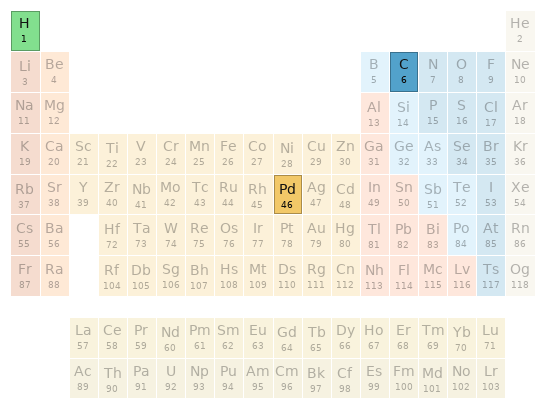
Periodic table location
Images
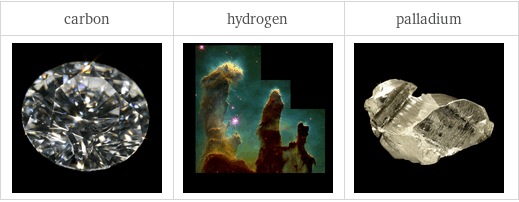
Images
Basic elemental properties
![| carbon | hydrogen | palladium atomic symbol | C | H | Pd atomic number | 6 | 1 | 46 short electronic configuration | [He]2s^22p^2 | 1s^1 | [Kr]4d^10 Aufbau diagram | 2p 2s | 1s | 4d block | p | s | d group | 14 | 1 | 10 period | 2 | 1 | 5 atomic mass | 12.011 u | 1.008 u | 106.42 u half-life | (stable) | (stable) | (stable)](../image_source/13ada86beb5216d3c3f391fdb09ca6ee.png)
| carbon | hydrogen | palladium atomic symbol | C | H | Pd atomic number | 6 | 1 | 46 short electronic configuration | [He]2s^22p^2 | 1s^1 | [Kr]4d^10 Aufbau diagram | 2p 2s | 1s | 4d block | p | s | d group | 14 | 1 | 10 period | 2 | 1 | 5 atomic mass | 12.011 u | 1.008 u | 106.42 u half-life | (stable) | (stable) | (stable)
Thermodynamic properties

| carbon | hydrogen | palladium phase at STP | solid | gas | solid melting point | 3550 °C | -259.14 °C | 1554.9 °C boiling point | 4027 °C | -252.87 °C | 2963 °C critical temperature | | 32.97 K | critical pressure | | 1.293 MPa | molar heat of fusion | 105 kJ/mol | 0.558 kJ/mol | 16.7 kJ/mol molar heat of vaporization | 715 kJ/mol | 0.452 kJ/mol | 380 kJ/mol specific heat at STP | 710 J/(kg K) | 14300 J/(kg K) | 240 J/(kg K) adiabatic index | | 7/5 | (properties at standard conditions)
Material properties
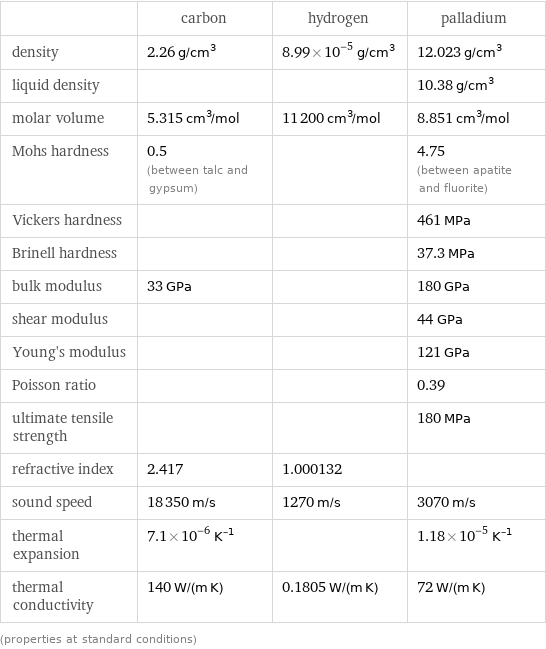
| carbon | hydrogen | palladium density | 2.26 g/cm^3 | 8.99×10^-5 g/cm^3 | 12.023 g/cm^3 liquid density | | | 10.38 g/cm^3 molar volume | 5.315 cm^3/mol | 11200 cm^3/mol | 8.851 cm^3/mol Mohs hardness | 0.5 (between talc and gypsum) | | 4.75 (between apatite and fluorite) Vickers hardness | | | 461 MPa Brinell hardness | | | 37.3 MPa bulk modulus | 33 GPa | | 180 GPa shear modulus | | | 44 GPa Young's modulus | | | 121 GPa Poisson ratio | | | 0.39 ultimate tensile strength | | | 180 MPa refractive index | 2.417 | 1.000132 | sound speed | 18350 m/s | 1270 m/s | 3070 m/s thermal expansion | 7.1×10^-6 K^(-1) | | 1.18×10^-5 K^(-1) thermal conductivity | 140 W/(m K) | 0.1805 W/(m K) | 72 W/(m K) (properties at standard conditions)
Electromagnetic properties
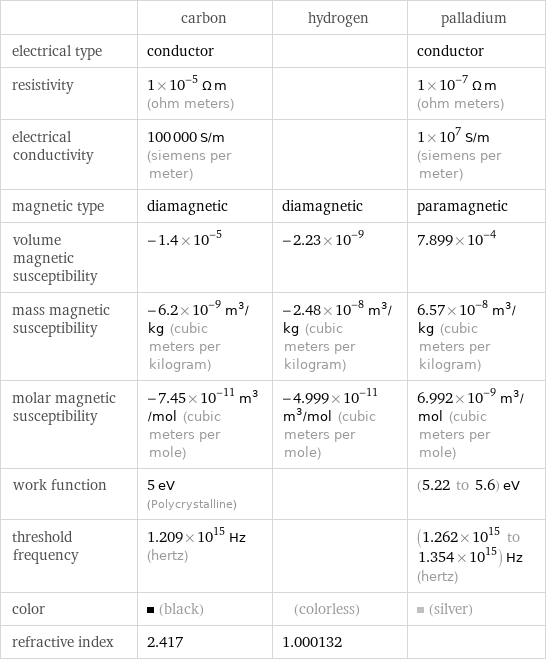
| carbon | hydrogen | palladium electrical type | conductor | | conductor resistivity | 1×10^-5 Ω m (ohm meters) | | 1×10^-7 Ω m (ohm meters) electrical conductivity | 100000 S/m (siemens per meter) | | 1×10^7 S/m (siemens per meter) magnetic type | diamagnetic | diamagnetic | paramagnetic volume magnetic susceptibility | -1.4×10^-5 | -2.23×10^-9 | 7.899×10^-4 mass magnetic susceptibility | -6.2×10^-9 m^3/kg (cubic meters per kilogram) | -2.48×10^-8 m^3/kg (cubic meters per kilogram) | 6.57×10^-8 m^3/kg (cubic meters per kilogram) molar magnetic susceptibility | -7.45×10^-11 m^3/mol (cubic meters per mole) | -4.999×10^-11 m^3/mol (cubic meters per mole) | 6.992×10^-9 m^3/mol (cubic meters per mole) work function | 5 eV (Polycrystalline) | | (5.22 to 5.6) eV threshold frequency | 1.209×10^15 Hz (hertz) | | (1.262×10^15 to 1.354×10^15) Hz (hertz) color | (black) | (colorless) | (silver) refractive index | 2.417 | 1.000132 |
Reactivity
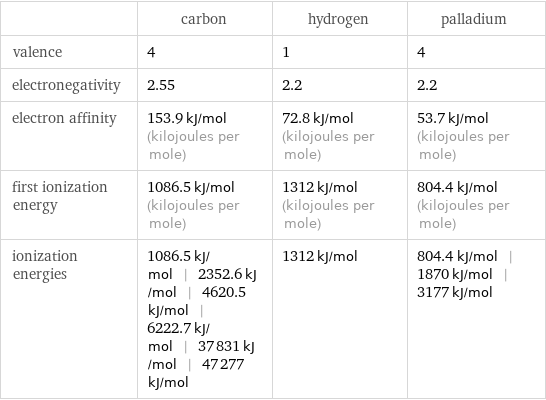
| carbon | hydrogen | palladium valence | 4 | 1 | 4 electronegativity | 2.55 | 2.2 | 2.2 electron affinity | 153.9 kJ/mol (kilojoules per mole) | 72.8 kJ/mol (kilojoules per mole) | 53.7 kJ/mol (kilojoules per mole) first ionization energy | 1086.5 kJ/mol (kilojoules per mole) | 1312 kJ/mol (kilojoules per mole) | 804.4 kJ/mol (kilojoules per mole) ionization energies | 1086.5 kJ/mol | 2352.6 kJ/mol | 4620.5 kJ/mol | 6222.7 kJ/mol | 37831 kJ/mol | 47277 kJ/mol | 1312 kJ/mol | 804.4 kJ/mol | 1870 kJ/mol | 3177 kJ/mol

Reactivity
Atomic properties

| carbon | hydrogen | palladium term symbol | ^3P_0 | ^2S_(1/2) | ^1S_0 atomic radius | 70 pm | 25 pm | 140 pm covalent radius | 76 pm | 31 pm | 139 pm van der Waals radius | 170 pm | 120 pm | 163 pm (electronic ground state properties)
Abundances
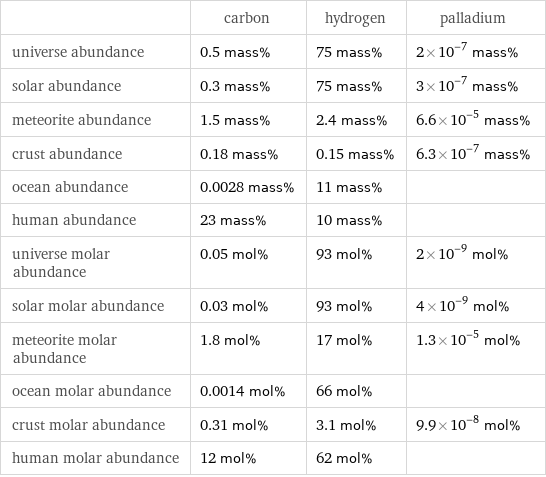
| carbon | hydrogen | palladium universe abundance | 0.5 mass% | 75 mass% | 2×10^-7 mass% solar abundance | 0.3 mass% | 75 mass% | 3×10^-7 mass% meteorite abundance | 1.5 mass% | 2.4 mass% | 6.6×10^-5 mass% crust abundance | 0.18 mass% | 0.15 mass% | 6.3×10^-7 mass% ocean abundance | 0.0028 mass% | 11 mass% | human abundance | 23 mass% | 10 mass% | universe molar abundance | 0.05 mol% | 93 mol% | 2×10^-9 mol% solar molar abundance | 0.03 mol% | 93 mol% | 4×10^-9 mol% meteorite molar abundance | 1.8 mol% | 17 mol% | 1.3×10^-5 mol% ocean molar abundance | 0.0014 mol% | 66 mol% | crust molar abundance | 0.31 mol% | 3.1 mol% | 9.9×10^-8 mol% human molar abundance | 12 mol% | 62 mol% |
Nuclear properties
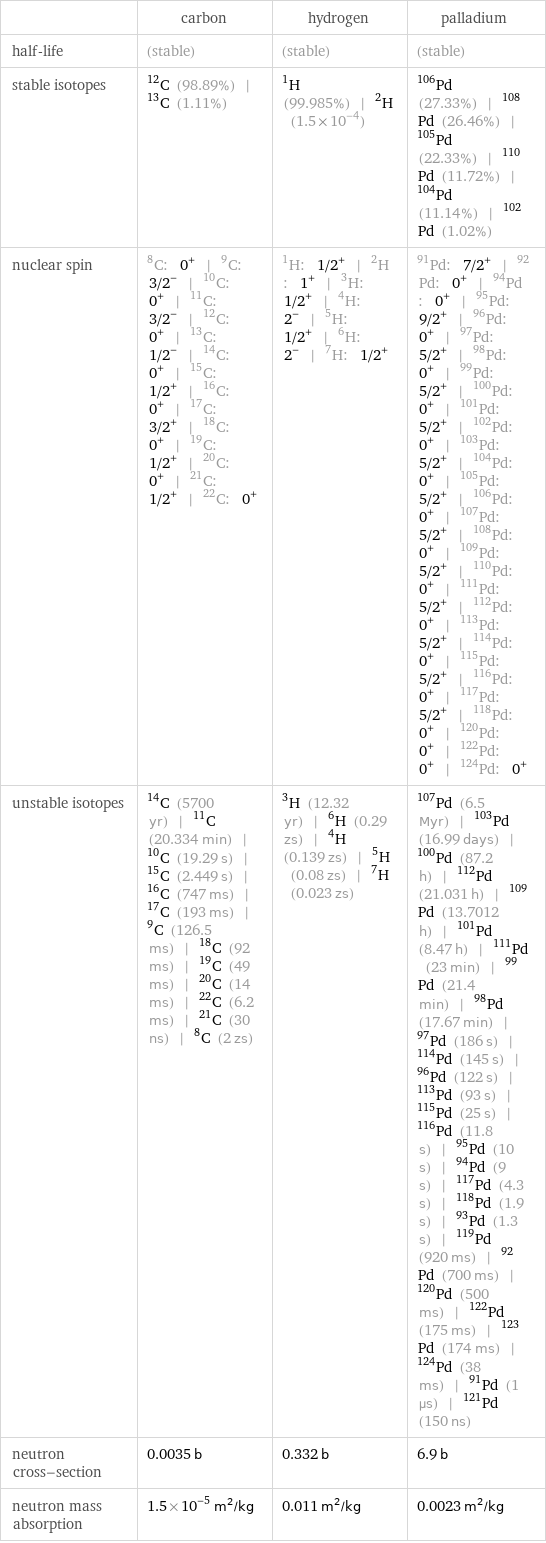
| carbon | hydrogen | palladium half-life | (stable) | (stable) | (stable) stable isotopes | C-12 (98.89%) | C-13 (1.11%) | H-1 (99.985%) | H-2 (1.5×10^-4) | Pd-106 (27.33%) | Pd-108 (26.46%) | Pd-105 (22.33%) | Pd-110 (11.72%) | Pd-104 (11.14%) | Pd-102 (1.02%) nuclear spin | C-8: 0^+ | C-9: 3/2^- | C-10: 0^+ | C-11: 3/2^- | C-12: 0^+ | C-13: 1/2^- | C-14: 0^+ | C-15: 1/2^+ | C-16: 0^+ | C-17: 3/2^+ | C-18: 0^+ | C-19: 1/2^+ | C-20: 0^+ | C-21: 1/2^+ | C-22: 0^+ | H-1: 1/2^+ | H-2: 1^+ | H-3: 1/2^+ | H-4: 2^- | H-5: 1/2^+ | H-6: 2^- | H-7: 1/2^+ | Pd-91: 7/2^+ | Pd-92: 0^+ | Pd-94: 0^+ | Pd-95: 9/2^+ | Pd-96: 0^+ | Pd-97: 5/2^+ | Pd-98: 0^+ | Pd-99: 5/2^+ | Pd-100: 0^+ | Pd-101: 5/2^+ | Pd-102: 0^+ | Pd-103: 5/2^+ | Pd-104: 0^+ | Pd-105: 5/2^+ | Pd-106: 0^+ | Pd-107: 5/2^+ | Pd-108: 0^+ | Pd-109: 5/2^+ | Pd-110: 0^+ | Pd-111: 5/2^+ | Pd-112: 0^+ | Pd-113: 5/2^+ | Pd-114: 0^+ | Pd-115: 5/2^+ | Pd-116: 0^+ | Pd-117: 5/2^+ | Pd-118: 0^+ | Pd-120: 0^+ | Pd-122: 0^+ | Pd-124: 0^+ unstable isotopes | C-14 (5700 yr) | C-11 (20.334 min) | C-10 (19.29 s) | C-15 (2.449 s) | C-16 (747 ms) | C-17 (193 ms) | C-9 (126.5 ms) | C-18 (92 ms) | C-19 (49 ms) | C-20 (14 ms) | C-22 (6.2 ms) | C-21 (30 ns) | C-8 (2 zs) | H-3 (12.32 yr) | H-6 (0.29 zs) | H-4 (0.139 zs) | H-5 (0.08 zs) | H-7 (0.023 zs) | Pd-107 (6.5 Myr) | Pd-103 (16.99 days) | Pd-100 (87.2 h) | Pd-112 (21.031 h) | Pd-109 (13.7012 h) | Pd-101 (8.47 h) | Pd-111 (23 min) | Pd-99 (21.4 min) | Pd-98 (17.67 min) | Pd-97 (186 s) | Pd-114 (145 s) | Pd-96 (122 s) | Pd-113 (93 s) | Pd-115 (25 s) | Pd-116 (11.8 s) | Pd-95 (10 s) | Pd-94 (9 s) | Pd-117 (4.3 s) | Pd-118 (1.9 s) | Pd-93 (1.3 s) | Pd-119 (920 ms) | Pd-92 (700 ms) | Pd-120 (500 ms) | Pd-122 (175 ms) | Pd-123 (174 ms) | Pd-124 (38 ms) | Pd-91 (1 µs) | Pd-121 (150 ns) neutron cross-section | 0.0035 b | 0.332 b | 6.9 b neutron mass absorption | 1.5×10^-5 m^2/kg | 0.011 m^2/kg | 0.0023 m^2/kg
Identifiers

| carbon | hydrogen | palladium CAS number | 7440-44-0 | 1333-74-0 | 7440-05-3 PubChem CID number | | 783 | 23938